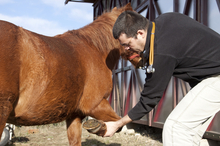Tildren (Tiludronic Acid) is a relatively new drug used to help horses with navicular syndrome and osteoarthritis. Much of the pain associated with navicular syndrome comes from breakdown and resorption of bone (osteolysis). The navicular bone can break down and remodel where stress is exerted on the cortical surface.

Lameness exam by a veterinarian
Tiludronate helps manage lameness by decreasing bone resorption and inflammation and also inhibits enzymes that break down cartilage in an osteoarthritic joint.
Break down of the bone where ligaments such as the distal sesamoidean impar ligament and the deep digital flexor tendon attach is usually present. Horses with osteoarthritis experience the pain of bone resorption and remodeling in areas where the cartilage is no longer functional and abnormal stress is placed on the bone below. Tiludronic acid inhibits painful breakdown of bone.
Tildren, the injectable form of tiludronate made for the horse, has been licensed to treat navicular disease and distal tarsal osteoarthritis in Europe.
Tiludronate is a compound in the bisphosphonate class of drugs. The main pharmacologic action of bisphosphonates is to inhibit bone resorption; they cause osteoclast apoptosis and disrupt intercellular trafficking of pro-inflammatory mediators.
Bisphosphonates are used to treat humans with diseases such as osteoporosis and Paget's disease. Recently tiludronate has been studied as a treatment for bone resorptive diseases in horses.
Some clinical studies have been completed to assess the efficacy of tiludronate in the horse. Tiludronate may be beneficial in managing lameness isolated to the navicular bone and distal tarsal osteoarthritis by decreasing bone resorption and inflammation.
Tiludronic acid also has inhibitory effects on the enzymes that break down cartilage within an osteoarthritic joint. Horses treated with tiludronic acid experience immediate inhibitory effects on bone resorption. The affects last up to 4 months.>/p>
A lame horse can experience some relief almost immediately after IV administration. Theosteolysis is controlled for approximately four months, giving the injured area time to heal. Tiludronic acid can be especially effective when the abnormal stress on the bone can be eliminated so that over the 4 months, as the bone heals, it will not be reinjured. Horses with Navicular Syndrome that get corrective shoeing fall into this category.
Read to learn more about Tildren
